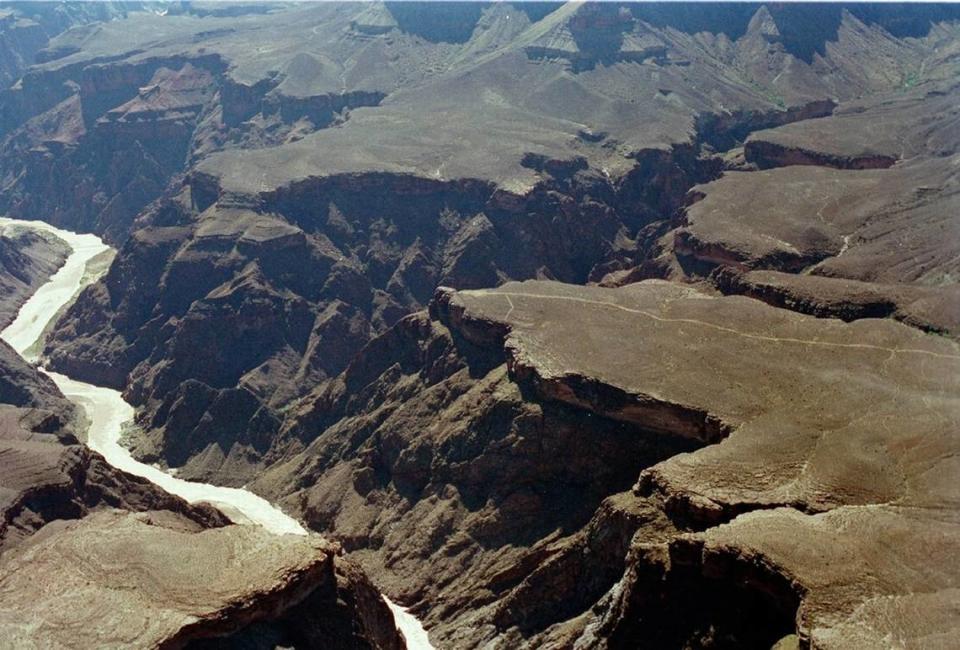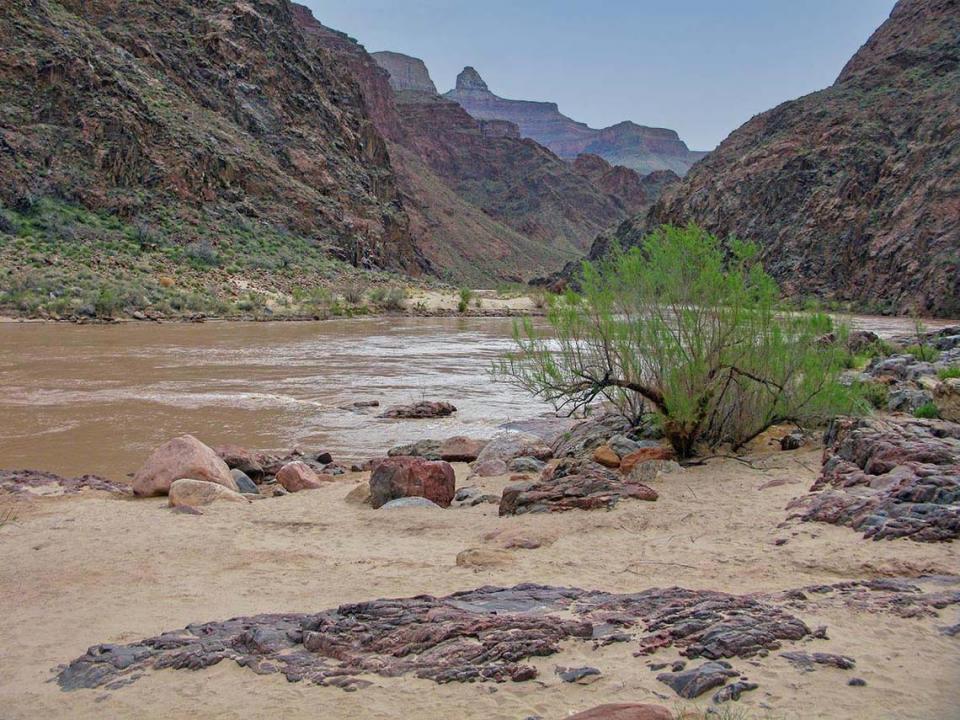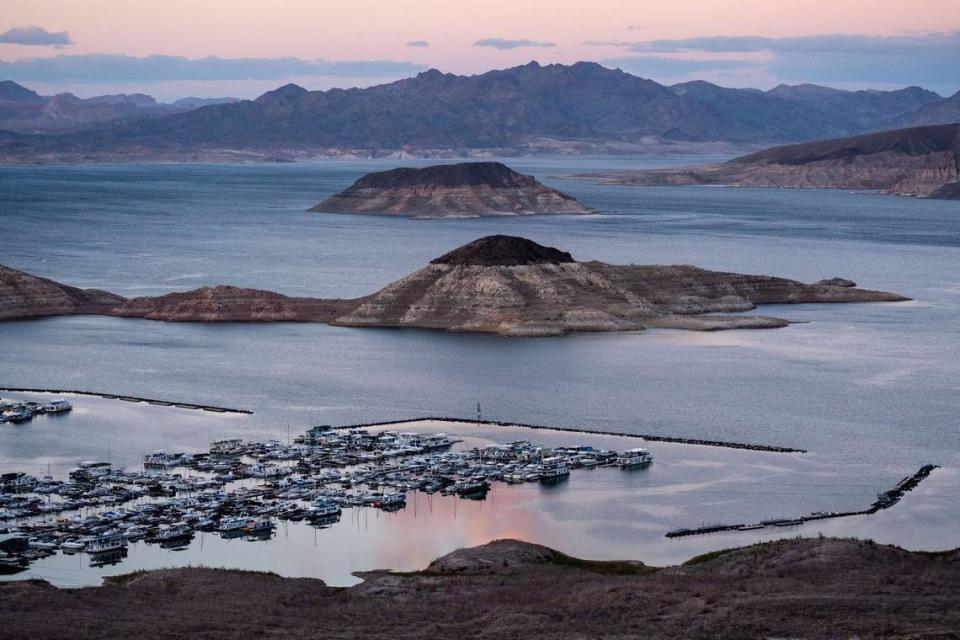Federal officials told states to curb Colorado River use. How will it affect California?
Despite a wet winter, California and other western states will still need to cut back how much water they draw from the Colorado River. The question federal and state officials are weighing is: How much will they each need to cut?
California, the largest beneficiary of the river’s supply, would face starkly different changes based on which proposal is selected. Most politicians and officials agree drought and overuse have resulted in such low water levels that action must be taken, but it is also possible that a proposal that is not on the table now comes through. While the Colorado River’s supply mainly serves Southern California, repercussions could eventually echo up and down the state.
The Colorado River, home to the massive Hoover and Glen Canyon dams, supports 40 million people, almost 6 million acres of agriculture and tribal communities across seven states and portions of Mexico, according to California’s Colorado River Board.
Almost half of those people reside in Southern California.
The river’s main reservoirs are Lake Powell in Utah and Arizona and Lake Mead in Nevada and Arizona. Lake Mead, which sends water to Southern California, currently holds less than a third of its capacity.
“Drought conditions in the Colorado River Basin have been two decades in the making,” U.S. Bureau of Reclamation Commissioner Camille Calimlim Touton said Tuesday. “To meet this moment, we must continue to work together, through a commitment to protecting the river, leading with science and a shared understanding that unprecedented conditions require new solutions.”
Potential water cuts

The Bureau of Reclamation, part of the U.S. Department of the Interior, released a draft environmental impact statement on Tuesday that analyzes potential changes to allotments from the Colorado River’s major dams and reservoirs. This would amend the 2007 rules that guide operations and are set to expire at the end of 2026. Officials are working on new terms to start then, but in the meantime, short-term revisions would start in 2024 and last through 2026.
Federal officials did not pick a resolution yet. Rather, they hoped the statement would urge Colorado River stakeholders to an agreement, which they have not succeeded in doing so far. Regardless, the Bureau of Reclamation plans to adopt a final draft this summer.
The Bureau of Reclamation presented three short-term alternatives that affect states on the river’s lower basin: California, Arizona and Nevada.
First was to do nothing, which detailed the consequences of continuing current operations that would worsen hydrologic conditions and reservoir levels.
The second and third alternative model would alter water usage from both the Glen Canyon and Hoover dams. The second alternative involved reducing allotments to areas in the lower basin which both Lake Powell and Lake Mead water on a seniority scale set by the current agreement, which would be less drastic for Southern California. The third alternative examines equal cuts, which would have more of an impact on groups that rely on the water most.
Effects of cuts will reach Northern California even though allotments are used down south. Already in 2022, the Metropolitan Water District of Southern California and Silicon Valley’s water agency made a $11.5 million deal to buy water from Sacramento and some of its suburbs.
More deals to make up for Colorado River cuts in the agricultural and urban areas of Southern California could be needed.
Lisa Lien-Mager, the senior advisor for strategic communications for the California Natural Resources Agency, said that impacts now would be centralized to Southern California. But as the state prepares for a hotter, drier climate, effects will stretch up and down the state.
The Bureau of Reclamation’s assessment is open for public comment through May. The final plan should be ready this summer, according to the Department of the Interior.
The agency reviewed alternatives after a period of consultation with states, tribal governments, communities and stakeholders of the water supply that started in October. It incorporated proposals from the seven states that rely on the Colorado River system: One came from Arizona, Colorado, Nevada, New Mexico, Utah and Wyoming, and the other from California.
“California remains committed to developing a seven-state consensus that will protect the Colorado River system for the duration of the current guidelines,” JB Hamby, chairman of California’s Colorado River Board who also serves as the state’s Colorado River commissioner, said Tuesday.
California recommendation for allotments

In January, the six states besides California proposed a conservation option based on water lost to evaporation and travel. This would result in the most severe cuts to California, the biggest user of the river’s resource and the state with senior water rights.
California countered with a plan that would put a greater burden of cuts on Arizona while it pledged to conserve up to another 400,000 acre-feet of water a year. An acre-foot is about what two average houses use in a year.
The state said this method would protect reservoir levels while prioritizing human health and safety. California claimed the other states’ proposal interfered with the current agreement, overstepped on its senior water rights and did not offer a resolution for cutbacks imposed on its residents. The current guidelines, set in 2007, were placed to provide certainty to water users about timing and amounts of potential water delivery reductions in the face of required conservation measures.
California said that to meet conservation guidelines, it will need federal funding and support for cross-state coordination. Specifically, California’s Colorado River Board mentioned bolstered collaboration to stabilize the Salton Sea in Southern California that has been shrinking due to other conservation efforts.
The state had cut about a fifth of its water use from the Colorado River in 2003 at the charge of the Interior Department to accommodate rising populations in Arizona and Nevada. That caused California to implement stringent conservation measures to get by on its allotment of 4.4 million acre-feet per year.
California reduced intake again through the Bureau of Reclamation’s 2019 Drought Contingency Plan.
“California has done its part and is willing to do more,” Jim Madaffer, vice chair of California’s Colorado River Board of California who represents the San Diego County Water Authority, said when it released its January plan, “but it’s time for the other states to step up and create their own conservation programs that sustain the quality of life in their communities.”
Federal resources
The Bureau of Reclamation, states and other users of the river system are also working on long-term guidelines that protect both the river system and people who rely on it. New guidelines need to be decided before the 2007 ones expire at the end of 2026.
Discussions over how to handle declining reservoir levels and reduced water influxes started last year when the Bureau of Reclamation warned that states needed to take drastic conservation efforts. It gave the seven states an August deadline to come up with an agreement.
Months went by without a resolution until the six states sent their proposal in January.
The Bureau of Reclamation’s Lower Colorado River Basin System Conservation and Efficiency Program, which the 2022 Inflation Reduction Act funded, aims to help with long-term conservation for the area. California, Arizona and Nevada recommended turf removal, local supply projects, agricultural improvements, conveyance modernization and storage works.

Thanks to the 2021 Bipartisan Infrastructure Law and Inflation Reduction Act, the Bureau of Reclamation is spending $8.3 billion over the next five years on water infrastructure and $4.6 million on drought issues. The administration under President Joe Biden promised that climate issues would be a priority through legislative efforts and executive actions.
The Interior Department is investing more than half a million dollars for Colorado River basin states that it expects will help conserve water. Money is going to water-recycling efforts, infrastructure repairs, a pipeline project and drought resiliency practices such as groundwater recharge, rainwater harvesting and water storage.
While heavy rain and snow helped cushion some of the Colorado River’s depletion, “Everyone who lives and works in the basin knows that one good year will not save us,” Tommy Beaudreau, deputy secretary of the Interior Department, said Tuesday. “The hydrologic trend is dire.”

